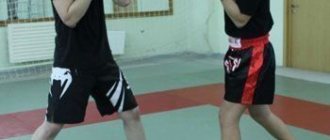Explosive strength in bodybuilding is not an important quality, except that during periods of stagnation caused by the body’s adaptation to stress, explosive exercises are able to overcome the so-called “growth plateau.” But in other sports, this ability is the decisive factor leading to victory! This indicator is needed in almost every sport. Athletes involved in any type of martial arts, track and field athletes (sprinters), participants in team sports, weightlifters, powerlifters, crossfitters, fencers, tennis players and many other athletes cannot do without explosive power. This ability allows you to achieve victory through one dash, throw, lightning and crushing blow!
What is explosive force
Explosive strength is the ability to mobilize all the body’s energy reserves and direct them to perform great efforts in the shortest possible time. During explosive movements, the muscles contract instantly. For example, before a jump, an athlete squats deeply, stretching the muscles, after which he makes a jerk, during which the so-called reactive movement occurs, the muscles instantly contract and direct him in the desired direction with maximum energy.
Muscle reactivity and explosive strength develop parallel to each other. When performing explosive movements, concentrated muscle tension occurs. But if reactive ability develops only with maximum stretching of the muscle fibers, as was described with the example of jumping, then explosive strength can be trained without stretching the fibers. For example, a boxer's punch when he throws a standing punch.
Good advice
I recommend listening to my advice, because they were told to me by an experienced weightlifter with extensive training experience behind him.
- Warm up. It is here that, as never before, it is extremely necessary. Warm up thoroughly, warm up your ligaments and joints, and tone your muscle fibers.
- Correct technique. Without the correct technique, this spectacle will be extremely funny, and, importantly, dangerous. Therefore, these workouts are recommended from an average level.
- It is best to do exercises with 2/3 of the entire amplitude. This way you can reach maximum speed.
- Find yourself a partner. Thanks to the belayer, you can not worry about the risk of injury and do exercises at a higher speed.
- Carefully monitor your level of well-being. With intense training, a weak body may not be able to withstand it and this will end in failure. Recommended exclusively for experienced athletes.
- Eat well. This training method is characterized by high energy consumption, which is why it is necessary to fully restore the spent strength, as well as provide the body with the necessary building material for muscles.
Dear friends, we talked about explosive strength, I talked about the most effective exercises, and gave valuable tips that will help you achieve truly explosive strength. All methods outlined in the article were taught by an experienced weightlifter. I recommend watching an interesting video. See you later.
Alexander Bely
Why develop explosive muscle power and who benefits from it?
Who needs it and why to develop it was partially described at the beginning of this article. In many sports, explosive strength plays a decisive role in achieving victory, and in some, like bodybuilding, it plays an indirect role, but sometimes bodybuilders cannot do without its development.
- Explosive strength plays a key role in weightlifting . Almost all exercises - snatch, clean and jerk, barbell clean - are performed with an instant squat and release and, by the way, the faster the transition from squatting to pressing a heavy weight (barbell), the better its performance will be.
- But in powerlifting, explosive strength, although important, does not play a key role. To perform exercises, powerlifters train mainly pure strength.
Working on flexibility
Helps you get fewer leg injuries
The last method may seem too simple, but the truth is that the more flexible you are, the more options you have for the position of your legs. Therefore, you will be less at risk of injury. The only way to improve your stretching is to get into the habit of doing flexibility exercises every day. This means you should do this every morning, before and after your workout, and before bed. Do a variety of exercises, starting very gently and gradually increasing the effort. Prepared by: Kirienko Mark
Recommendations for training for explosive strength
There aren't many recommendations.
- Firstly, exercises to develop explosive strength should be performed only after a good, effective warm-up, when the muscles have become toned and warmed up.
- Secondly, you should not load sports equipment with heavy weight or immediately set high goals for yourself, for example, jumping onto a one and a half meter platform from a standing position. Start with a low-height platform and gradually move to higher ones.
- Third, until your muscles have adapted to explosive loads, it is best to focus your training on bodyweight exercises. Subsequently, exercises with your own weight can be complicated with small dumbbells or weights.
For beginners , exercises such as all types of burpees, jumping with alternating legs or air lunges, push-ups, and ball throws are suitable.
By following these simple recommendations, you can minimize the risk of injury and take the right path to achieving your goal.
Running technique
It is important for runners to know how to develop explosive running speed. It is advisable to strengthen your feet, knees, back and core, which will help further increase your speed. For this purpose, exercises have been developed that involve certain muscle groups that are responsible for speed characteristics. They are based on running:
- in place and moving forward. In this case, the athlete’s hips are raised high, the legs are bent at the knees, and the elbows are pressed to the body. When performing the exercise, you should touch your palms with your knees;
- standing upright. The runner in place raises his hips as high as possible, holding onto the support with his hands;
- touching your heels to your buttocks;
- with acceleration. It not only perfectly develops the explosive power of the legs, but also trains the cardio-respiratory system;
- variable. The athlete runs slowly, accelerates and again switches to a slow pace;
- 100-meter (an exercise for explosive running power);
- On the stairs.
Number of repetitions and approaches
Training to develop explosive strength should consist of a set of three to six exercises. The number of approaches and repetitions will depend on the training of the athlete and the complexity of the exercises that he will perform.
- If you do light exercises , such as those performed without weights, you can do two to four sets of 10 repetitions.
- If you perform heavy exercises , such as a snatch, jumping on a weighted stand, or some complex plyometric push-ups, then the number of approaches can be increased from three to seven and performed two to three repetitions.
As an example, consider circuit training for trained athletes.
In it, one circle consists of three exercises. They must be performed one after another with a break of ten seconds.
- Exit by force.
- Ten second break.
- Jumping on the stand.
- Ten second break.
- Throwing out the ball.
- Ten second break.
After a 90-second rest, you can perform the next circuit.
Training principles
- At the beginning of the workout, a good active warm-up is required with elements of high-quality dynamic stretching of all muscles that will be involved.
- It is worth training explosive strength 1-2 times a week, and performing your usual basic program 1-2 times a week. The cycle lasts from 3 weeks to 1.5 months.
- The movement should be completed in 1-1.5 seconds. If one repetition takes more than 2 seconds, then you should reduce the weight. Otherwise, the training will not lead to the desired result and will not provide sufficient neuromuscular load.
- In one approach you need to perform from 3 to 10 repetitions, the duration of the set is from 5 to 10 seconds.
- Exercises that work several muscle groups can be done in 2–6 rounds, local exercises can be done in 4–12 rounds.
The following principles can be used in one program:
- The principle of speed. During your workout, use a weight that you can do no more than 6-7 reps with. Perform the first phase of the movement as quickly as possible, “exploding”, and return to the starting position as slowly as possible. Do no more than 2 approaches. Work according to this principle no more than once a week;
- The principle of progressive rest . Set the weight with which you will only do three repetitions. Do them, then rest for 30 to 45 seconds. After the next approach, rest for 45 seconds to a minute. And after the third time - a minute - one and a half. Then complete round 4;
- The principle of progressive loading. With each workout, increase the number of approaches and working weight.
Training for explosiveness in the bench press
Prepare a weight - 60-70% of what you could squeeze just 1 time. Perform exercises in 3 sets. To increase the load in the future, add weight, not sets.
Classic press
Take your starting position on the bench, take the barbell from the racks, extend your arms and, while inhaling, smoothly lower the barbell until it touches your chest. With a sharp exhalation, squeeze the top out as quickly as possible, then lower it back three times slower. Perform 6 – 10 repetitions. Even if the speed slows down each time, still try to do the exercise at maximum speed. For variety, you can use rubber or chains.
Squat press
Take the starting position: straight back, half squat (110-120 degrees), head in a natural position, look forward. Raise the barbell sharply and at the same time straighten your legs. The movements of the arms and legs must be strictly synchronized. Perform 3-6 repetitions in 1 set.
Half squat dumbbell press
Take the starting position: straight back, half squat (110-120 degrees), head in a natural position, elbows pointing forward. Raise the dumbbells sharply and at the same time straighten your legs. Halfway through the rep, change your arm position so that your elbows are turned outward. In this position, squeeze all the way. Perform 3-6 repetitions in 1 set. This exercise will also engage the quadriceps. Can be performed with weights.
Leg Explosive Strength Training
Prepare a weight of 55-60% of the maximum.
Box squats 60 cm
The height of the box may be different, the main thing is that squatting on it completely imitates a squat without support: the thigh-shin angle is 90 degrees. Legs wide, toes turned to the side at 45 degrees. We squat on the box, relaxing our hips and buttocks. Then we rise sharply, eliminating the “spring effect” (we don’t spring, we don’t push away from the box). You should also not lean back or swing to get up. We perform 2 repetitions - 7-9 approaches with a break of 30-45 seconds.
Box squats 60 cm with band
We install the rubber in line with the legs at the moment of lifting up, the place where the rubber is attached is clearly under the barbell (under the weights). At the top the rubber should have almost maximum tension, at the bottom it should be weaker. You can complicate the program both by increasing the weight of the barbell and by tightening the rubber. We perform 2 repetitions - 7-9 approaches with a break of 30-45 seconds.
Jumping from a squat onto a box
The position of the legs is the same as for squats. We install a 60 cm box for the seat, and after 2 meters - another, 1 meter high. We swing our arms and make an explosive jump from a squat onto a box, landing on our toes.
You can make it more difficult by the distance at which the jump box is installed. You can increase it gradually during your workout. And when the maximum distance is set, you need to make 5 jumps in this position. Rest between jumps for 10-15 seconds, perform the maximum number of repetitions.
Jumping from a squat onto a box with weights
You can pick up a medicine ball and gradually increase the load, finally jumping with weights. Rest between jumps for 10-30 seconds, perform the maximum number of repetitions.
High jumps with a spring
Set the obstacle to the maximum height you can jump to. We squat into a deep squat, push off with our hands and jump onto the surface. Rest between jumps for 10-30 seconds, perform the maximum number of repetitions.
Pull-up explosiveness training
Dips
They need to be performed with weights for 8-10 repetitions - 3-4 approaches.
Pull-ups on the bar
During the exercise, you need to “throw” yourself up, and then lower yourself as slowly as possible.
Deep pull-ups
It is necessary to sharply lift yourself up to chest level, while maintaining the body position strictly perpendicular to the bar - thus maximizing the use of your back. Perform 3-5 repetitions for 3-4 sets.
Coming out with force
Pulling yourself over the bar to below your stomach with a sharp grip. Pull yourself sharply above the horizontal bar, then bend your wrists and squeeze yourself above the horizontal bar. Perform 3-5 repetitions for 3-4 sets.
Exercises to develop explosive strength
Below we will present exercises that develop explosive strength, including exercises for both entry-level athletes and experienced athletes.
Falling from a height followed by a jump
From a height (bench) the athlete falls down. During the fall, kinetic energy accumulates, and during landing, an eccentric muscle contraction occurs, which is replaced by a concentric one - jumping up.
To prepare for this exercise, you can perform jumps on steps, from foot to foot, and in length.
Barbell Chest Raise
When holding the barbell vertically with straight arms, an eccentric contraction of the muscle fibers occurs, and at the moment of the jerk, after which the barbell moves to the chest, the muscles instantly switch from eccentric contraction to concentric.
This exercise should be performed with light weight. 50% of one repetition maximum is considered optimal.
Barbell snatch row
Just like the barbell clean, this exercise is performed as quickly as possible. In this exercise, there is a short pause between the pull and the pull. Thanks to the pause, inertia is reduced and the load during detonation increases. The optimal weight for performing this exercise is 50% of the maximum.
Thrusters
The barbell is placed in front of you on your shoulders, your elbows rise as high as possible. Thrusters are performed in this way: first, a squat is performed (an eccentric contraction occurs), after which the legs are straightened with an explosive movement. At the same time as you lift, you need to push the barbell up above your head.
Plyometric push-ups
There are many varieties of push-ups of this type. They are performed with jumping, clapping, lifting after stretching the muscles. You can choose just one, or you can make a whole complex.
Burpee
The simplest version of burpees is push-ups followed by jumping. But, like plyometric push-ups, there are a lot of them.
Here are some more of them:
- With jumping onto the cabinet.
- With pull-ups, with jumps and without.
- With a clap while jumping.
Jumping to higher ground
This exercise can be performed with muscle stretching (eccentric phase), which will allow you to develop not only explosive, but also reactive strength, or without muscle stretching, when the athlete jumps from a standing or sitting position. In the second case, the athlete performs the exercise with completely relaxed mice before making the jump. This exercise can be complicated by using various types of weights.
Jumping out of a pistol
This is a complex and difficult exercise. When performing it, the load falls on one leg.
Jumping with alternating legs
An excellent exercise for beginner athletes. The task is to jump out of the lunge as quickly as possible and change legs.
>
Throwing the ball
This exercise is one of the basic ones in CrossFit. A heavy medicine ball is suitable for this exercise. The leg muscles stretch during a squat, and during a throw they sharply straighten in a jump, while the ball is thrown over the head.
Execution Features
Before starting training, experienced athletes recommend warming up. If you plan to exercise for 45 minutes, at least 10 minutes should be spent on warm-up and stretching exercises. The main efforts are directed at the muscle groups that will have to experience the most significant load.
Rest intervals should be about 30 seconds between sets, since explosive running exercises do not particularly fatigue the muscles. After performing one exercise and before starting another, the warm-up time is 1-2 minutes.
When it is necessary to eliminate excessive tension, perform downhill running and slow running. To reduce the stress on the joints, if you have to perform jumps, you should choose a non-rigid surface for landing.
Each exercise is done in strict accordance with the technique of its implementation in order to avoid mistakes and injuries.
Thanks to explosive running, muscles are trained, toxins are eliminated, and organs are enriched with oxygen. After a successful run, the happiness hormones endorphin and serotonin are released, so your mood becomes positive. In addition, explosive running promotes the development of self-control, willpower, and determination. Forward!
https://youtu.be/bnXskgdwvzE
Exercises for endurance
The training program is developed in such a way that all running and jumping movements are included in it. Thus, the muscles of the body remember the basic skills with the help of which the athlete’s speed improves every time.
By performing certain loads while running, you can develop explosive strength - the ability to show the greatest strength in a short time. Plyometric (ballistic) movements aimed at stretching and contracting muscles most contribute to the development of explosive strength when running.
Speed staircase
There are a lot of exercises with speed ladders that develop leg speed and coordination of movements. This effective 6- or 10-meter-long, half-meter-wide exercise machine looks like strong nylon strips, between which flexible strips are attached at 40-centimeter intervals. The staircase improves running, helps improve speed skills, develops strength, endurance, ability to maneuver, and coordination of movements.
The ladder is used for training on the ground, placed on a horizontal surface for its entire length. The cell sizes are selected so that all exercise points are performed with the required amplitude and frequency. Perform 3-4 exercises at a time, 5-15 times, with 2-minute breaks between sets.
By repeating the exercises several times, you can increase control over body balance and hone the synchronization of movements:
- Running between the bars. The essence of the exercise is to run between the rungs of a ladder lying on the surface without touching them or touching the ground with your heels. First in one direction - to the end of the stairs, then - back.
- "Step - cage sideways." Performed by shifting to the left and right sides. Turning sideways, they run between the steps of a ladder laid on the ground, then in the opposite direction.
- "Two steps - a cage." It is performed with an accelerated rearrangement of the legs in the cage in one direction, then in the opposite direction.
- "Jump - bounce." With their feet parallel to each other, they jump into the first cage, then spread their legs and make a jump so that their feet are on both sides of the stairs. The next movement is feet together, jump, and so on until the end of the stairs.
- "Square". Performed with a 90 degree turn left and right. Jumps are made inside the stairs with a rotation of the torso.
- Jumping on one leg in a straight line and to the side. The exercise is performed by turning first to face the stairs, and then sideways, at a 90-degree angle to it.
- Running with your knees raised high. Run along one line, take one step into each stairwell, knees in front, heels under the hamstrings.
- Jumping with alternating legs. They jump into each stairwell on one leg.
Jump rope
Various types of exercises with a skipping rope contribute to the development of motor coordination, leg speed and endurance. These activities improve your running performance and reduce the risk of injury because they strengthen your muscles without putting strain on your joints. Training with the apparatus improves coordination and balance, helps reduce the time of foot contact with the ground while running and increases cadence (the frequency of a runner's steps per minute). A daily 10-minute workout with a jump rope is equivalent to half an hour of running.
When starting classes, you should take into account that you should start with a short warm-up of 5-10 minutes, gradually adding up to 20-30 minutes. For beginners we can recommend:
- jumping on both legs (10 times);
- alternating jumps on the right and left legs (10 times each);
- alternating legs while jumping (20 times).
One round is 50 repetitions.
To train explosive running speed, use more intense exercises:
- They jump for 3 minutes, rest for 1 minute and start jumping again (from 3 rounds).
- "Pyramid". After completing 10 jumps, give yourself a short break, then add 10 more, rest and train until the number of repetitions reaches 100.
- “Tabata”: make quick jumps for 20 seconds, rest for 10 seconds and jump again, performing 8-10 rounds.
- Crossfit exercise. Perform burpees 10 times (squat-lying position-jump), then jump rope 50 times, reducing the number of burpees by 1 each time. Repeat 50 times.
- "Intervals 30x30." For 30 seconds, they take turns jumping rope, doing push-ups and squats.











